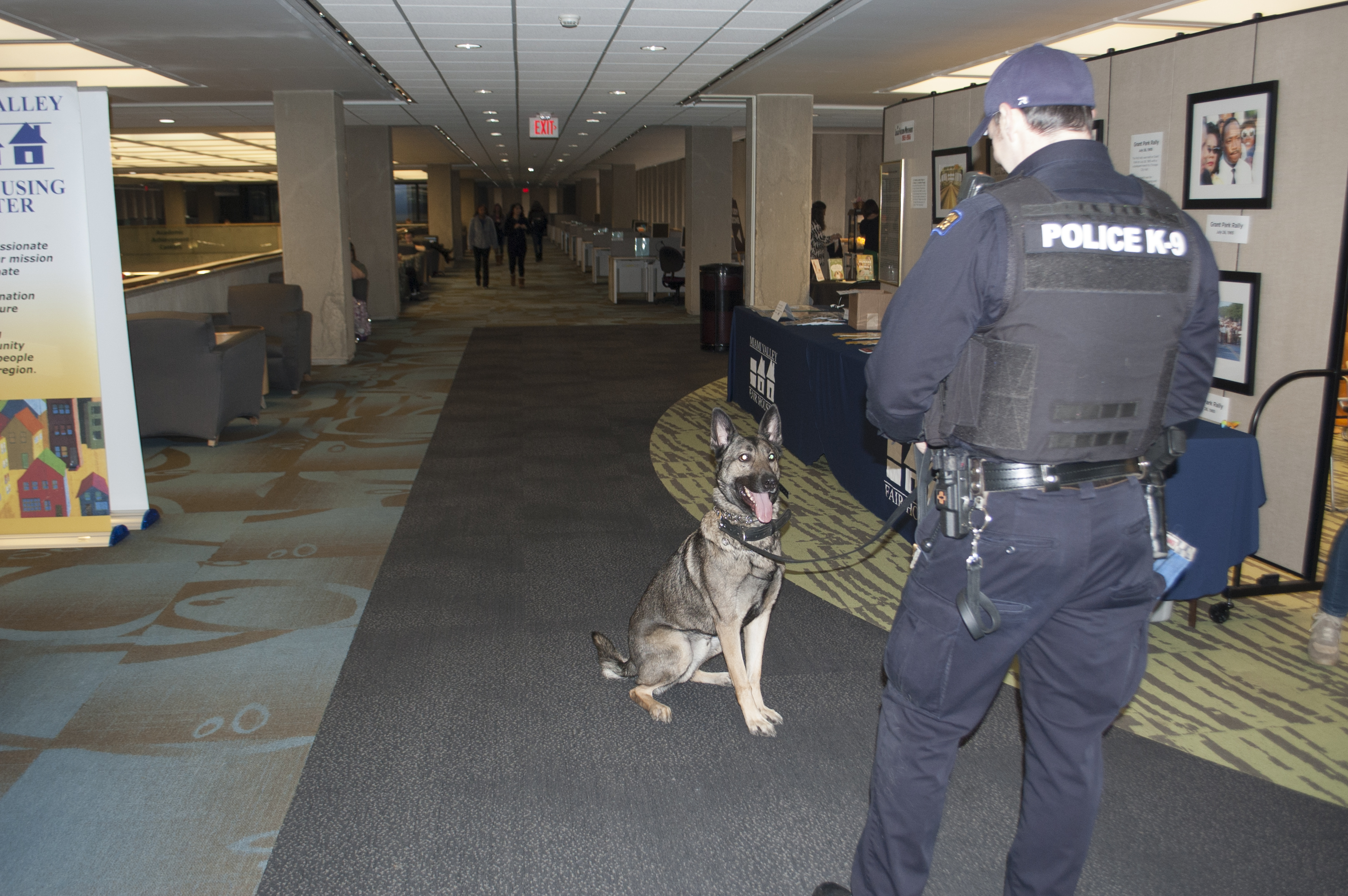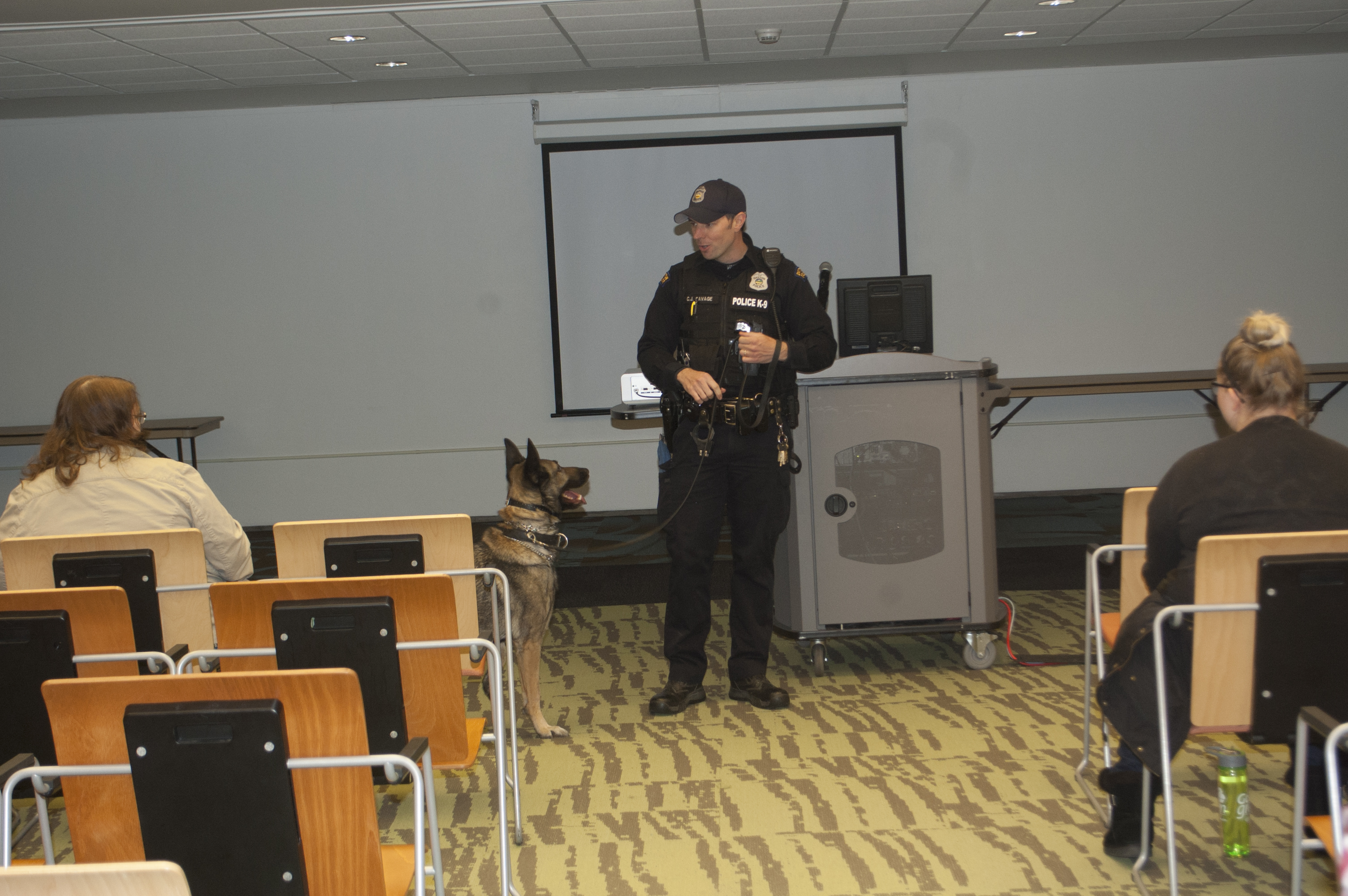On Wednesday April 4, Sinclair College had the opportunity to welcome a few officers from the Dayton Police and Montgomery Police Departments, and their furry companions. At this Sinclair Talks through, the focus was more on the K-9’s and less on the policemen.
The event kicked off with Officer Savage from Dayton Police introducing his German Shepard, Jake (a beautiful name if you ask me) to the audience. After the cooing from the audience died down, Officer Savage went right into revealing information on his companion.
“It is not as easy to get a police dog as one might think,” Officer Savage informed the audience, “Once your department has the money (around 7,000 dollars) the handler goes to a school in Fort Wayne Indiana for 14 weeks.”
At this school the handler stays with the dog during both free time and work time, they become a duo. The handler is taught all of the basic training, from dog handling to basic first aid for dogs.
Of course there is a large portion of time dedicated to training the dog for police work. One of the activities the officer spoke of was bite training.
 “The dogs are trained to go for people’s arms when they chase them down,” Officer Savage began, “but they will take what they can get. The dog will never go for the face, neck, or genitalia though, as that would be cruel and could cause serious damage.”
“The dogs are trained to go for people’s arms when they chase them down,” Officer Savage began, “but they will take what they can get. The dog will never go for the face, neck, or genitalia though, as that would be cruel and could cause serious damage.”
“It is more than just me training the dog though,” Officer Savage informed the audience. “The dog trains you. By spending all that time together you learn what the dog is thinking, and what the dog needs.”
Officer Bemis, the next speaker, backed up these claims. “When I became a handler my first dog taught me more than I ever taught, how to understand what the dog needed me to do, and what communication worked best. My first dog was bilingual, he came over knowing German. I didn’t think in the heat of the moment I would be able to remember German commands, so we switched him to English. This took time, so with my next dog I stuck to German. I use that information to this day, to work with the dog I have now.” He said.
Officer Bemis then informed the crowd that the handler actually gets to pick which dog they want.
“When you first get to the 14 week school, you get to pick your partner. I picked my dog Jax here because he was lighter than other dogs, that way he could jump over a fence instead of me having to lift him [laughs].”
You need the right dog for the right job of course. Some dogs are better at chasing down criminals, while others have better sniffers. That being said, the vast majority of police dogs are German Shepherds.
The reason for this is that German Shepherds are great all purpose dogs. They are one of the more intelligent dogs, great at chasing down people, possess a very powerful bite and while they might not have as good a sniffer as a Bloodhound, they are certainly one of the best. All of this utility lends itself to a wide range of training, ergo a greater chance to be picked for this line of work.
 “K-9 officers are just as valuable as the human officers. Unfortunately they often get overlooked.” officer Savage said.
“K-9 officers are just as valuable as the human officers. Unfortunately they often get overlooked.” officer Savage said.
These police dogs have a life outside of sniffing out drugs and chasing criminals, at the end of the day they go home with their partner and engage in everyday family life.
“When I take Jax home he goes to play with my kids,” Officer Bemis informed the audience, “He becomes like any other dog, and of course he sheds everywhere. I originally couldn’t stand all the hair, but it is a part of life now.”
There are problems of course, as big dogs are known for having hip problems and police work complicates this. That is why more often than not the handler will stay with the dog after the dog retires, since they understand what the dog needs.
At the end of the dogs career, the handlers are allowed to purchase them from the city for $1.00, and most of the time they do. The dog retires to a life of ball chasing and belly scratches, peacefully living into old age.
Jake Conger
Reporter


